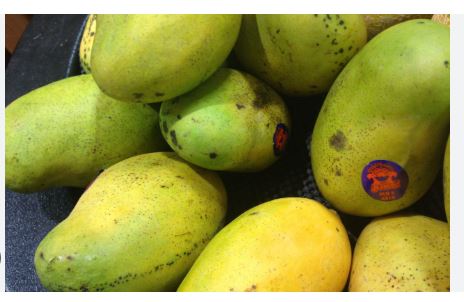
Francis mangoes are classified as Mangifera indica, a species within the Anacardiaceae family, which also includes cashews, pistachios, and sumacs. The genus Mangifera comprises around 35-40 species of tropical fruiting trees, with M. indica being the most widely cultivated, encompassing hundreds of cultivars globally. Francis is a polyembryonic variety, meaning its seed can produce multiple shoots, a trait typical of Southeast Asian mangoes rather than the monoembryonic Indian types. Originating from natural selection rather than controlled breeding, it reflects the adaptability and diversity within this species.
The Francis mango, also known as Madame Francis, traces its origins to Haiti, where it emerged as a seedling selection likely introduced from the West Indies or Southeast Asia centuries ago. Its exact history is murky, but it’s believed to have been cultivated by Haitian growers for generations, with roots possibly tied to early colonial exchanges following mango introductions to the Caribbean in the 18th century. By the late 19th and early 20th centuries, it was brought to South Florida, where it became a favored dooryard variety due to its adaptability to local conditions. Though not a major commercial cultivar like Tommy Atkins or Keitt, it remains popular in Florida’s home landscapes and is celebrated at events like the Fairchild Tropical Botanic Garden’s Mango Festival, reflecting its regional significance.
Francis mangoes are medium to large, typically weighing 12-20 ounces (340-570 grams), with an oblong-to-oval shape and a slightly flattened, S-curved profile. Their skin is smooth and thin, transitioning from green to a bright golden-yellow when ripe, often with a faint orange or pink blush near the stem. The flesh is a deep yellow-orange, soft, juicy, and fibrous—more so than many modern cultivars—surrounding a polyembryonic seed that can produce multiple seedlings. Ripening from May to July in Florida, it’s an early-to-mid-season variety with a potent, fruity aroma. The taste is rich and sweet, with a pronounced tropical flavor blending pineapple and peach notes, balanced by a mild tartness, offering a juicy, succulent experience despite its fiber content.
Mangifera indica ‘Francis’ thrives in USDA zones 10-11, where frost-free, tropical to subtropical conditions prevail, with temperatures ideally between 70-95°F (21-35°C). It can tolerate brief dips to 30°F (-1°C), but prolonged cold below this damages or kills the tree, limiting its U.S. cultivation to southern Florida, coastal California, Hawaii, and Puerto Rico. In zones 9b-10, it can be grown with protection (e.g., greenhouses or frost cloths) if started indoors and shielded from winter chill, though fruit production may be less consistent. It requires full sun (6-8 hours daily) and well-drained, sandy loam soil (pH 5.5-7.5), performing best in humid regions with 30-100 inches of annual rainfall or irrigation.
Culinary Applications of Francis Mangoes
- Fresh Eating: Sliced or spooned, their tangy-sweet flesh offers a refreshing tropical bite straight from the rind.
- Smoothies: Blended with pineapple or orange juice, they add a zesty, vibrant kick to creamy drinks.
- Salsas: Diced with habanero and onion, they bring a sweet-heat balance to fish or jerk chicken.
- Desserts: Pureed into sorbets or tarts, their bright flavor shines with a hint of tartness.
- Salads: Cubed into spinach or quinoa bowls, they pair well with citrus dressings or feta.
- Grilling: Sliced and grilled, their firmness holds up, complementing savory dishes like pork chops.
- Preserves: Cooked into jams with a touch of lime, they offer a bold, tangy spread for breads.
- Cocktails: Muddled into rum punches or mojitos, they infuse drinks with a lively, fruity twist.
Cultivation of Francis Mangoes
- Climate: Francis mangoes flourish in tropical climates, requiring warm temperatures between 70–95°F (21–35°C). They need a dry period of 2–3 months to initiate flowering, followed by humid conditions to support fruit development, making coastal Caribbean regions ideal.
- Soil: They grow best in well-drained, loamy or sandy loam soils with a pH of 5.5–7.5. Rich in organic matter, the soil should avoid waterlogging, as their roots are sensitive to excess moisture, though they tolerate coastal sandy conditions well.
- Propagation: Grafting onto hardy rootstocks like ‘Turpentine’ or local polyembryonic varieties is standard, preserving the Francis traits and speeding fruiting (within 3–5 years). Seedlings are less common due to inconsistent quality.
- Planting: Trees are spaced 20–25 feet (6–7.5 meters) apart to accommodate their moderate size, planted at the onset of the rainy season in pits enriched with compost to encourage strong root establishment.
- Irrigation: Young trees need regular watering (1–2 times weekly) for the first 2–3 years; mature trees rely on seasonal rains, with minimal irrigation during the dry flowering phase to avoid disrupting bloom.
- Pruning: Light pruning after harvest shapes the canopy, removes dead or crowded branches, and keeps trees at 10–15 feet (3–4.5 meters) for easier harvesting, enhancing airflow to reduce disease risk.
- Fertilization: A balanced fertilizer (e.g., 10-10-10) is applied 2–3 times yearly, with extra potassium to boost fruit flavor. Excessive nitrogen can increase fiber in the flesh, which growers aim to minimize.
- Flowering: Triggered by a dry spell or cooler nights (50–60°F or 10–15°C), flowering occurs in late winter to early spring. Pollination depends on bees and flies, with minimal cold stimulus needed for consistent blooms.
- Fruiting: Fruits mature in 100–120 days, ripening from May to July in Haiti and South Florida. A mature tree (7–10 years) can yield 150–250 kidney-shaped mangoes, typically weighing 1–2 pounds each.
- Pest Management: Susceptible to anthracnose and fruit flies, they require proactive care—neem oil or copper-based fungicides are used, especially in humid interiors, though coastal breezes help mitigate issues.
- Harvesting: Fruits are hand-picked when mature but green (showing a yellow color break), handled gently due to their perishability, and ripened off-tree to a golden yellow for optimal sweetness and texture.
- Yield Considerations: Francis mangoes produce reliably in coastal areas with good airflow, but yields can dip in overly humid inland zones due to anthracnose. Thinning blooms can improve fruit size and reduce biennial bearing tendencies.